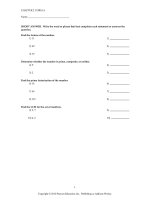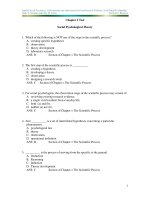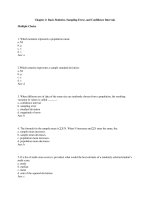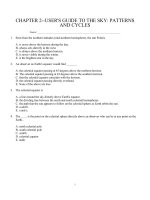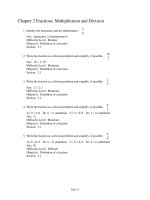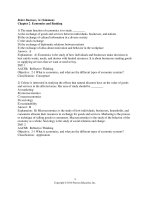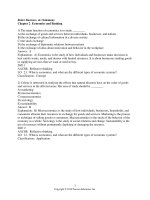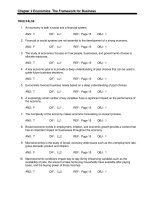Better business 2nd edition solomon test bank
Bạn đang xem bản rút gọn của tài liệu. Xem và tải ngay bản đầy đủ của tài liệu tại đây (292.03 KB, 40 trang )
Better Business, 2e (Solomon)
Chapter 2 Economics and Banking
1) Microeconomics is the study of the behavior of the overall economies of small countries.
Answer: FALSE
Explanation: Microeconomics is the study of how individual businesses, households, and
consumers make decisions to allocate their resources in the exchange of goods and services.
Macroeconomics is the study of the behavior of the overall economy.
Diff: 1
Page Ref: 29
AACSB: Analytic Skills
Objective: 2-1 What is economics, and what are the different types of economic systems?
Skill: Conceptual
2) Macroeconomics is the study of how certain occurrences affect the economy as a whole.
Answer: TRUE
Explanation: Macroeconomics is the study of the behavior of the overall economy.
Diff: 1
Page Ref: 29
AACSB: Analytic Skills
Objective: 2-1 What is economics, and what are the different types of economic systems?
Skill: Conceptual
3) The supply of services is not part of the study of economies because it does not involve the
exchange of goods.
Answer: FALSE
Explanation: The supply of services is part of the study of economics because services are
exchanged for resources the same way goods are.
Diff: 1
Page Ref: 29
AACSB: Analytic Skills
Objective: 2-1 What is economics, and what are the different types of economic systems?
Skill: Conceptual
4) Economics is the study of how goods and services are exchanged between individuals,
businesses, and governments.
Answer: TRUE
Explanation: Economics is the study of how individuals and businesses make decisions to best
satisfy wants, needs, and desires.
Diff: 1
Page Ref: 29
AACSB: Analytic Skills
Objective: 2-1 What is economics, and what are the different types of economic systems?
Skill: Conceptual
1
Copyright © 2012 Pearson Education, Inc.
5) Traditional economies are the most common economies found in the world today.
Answer: FALSE
Explanation: Traditional economies were agrarian in nature and were based on strong social
networks. They are very uncommon today. Most economies today are either mixed economies or
market economies.
Diff: 1
Page Ref: 30
AACSB: Analytic Skills
Objective: 2-1 What is economics, and what are the different types of economic systems?
Skill: Conceptual
6) In a planned economy, an individual's personal income dictates this or her spending choices.
Answer: FALSE
Explanation: In a planned economy, the government determines wages and sets prices, and
resources are distributed throughout the group. In a market economy, the individual's personal
income controls their purchasing decisions.
Diff: 1
Page Ref: 30-31
AACSB: Analytic Skills
Objective: 2-1 What is economics, and what are the different types of economic systems?
Skill: Conceptual
7) Although the United States comes close to being a capitalist economy, it is considered a
mixed economy because there is some government intervention.
Answer: TRUE
Explanation: Capitalism is an economic system that allows freedom of choice for both buyers
and sellers and encourages private ownership of resources. However, it is a mixed economy
because its government does collect and distribute some resources under certain circumstances.
Diff: 1
Page Ref: 31
AACSB: Reflective Thinking
Objective: 2-1 What is economics, and what are the different types of economic systems?
Skill: Conceptual
8) Business managers do not need to be aware of the decisions of collective businesses outside
their own industry.
Answer: FALSE
Explanation: Business managers need to be aware of any decisions by the government (e.g., a
change in interest rates) or by collective businesses (e.g., the level of unemployment) that may
impact the economy as a whole.
Diff: 1
Page Ref: 32
AACSB: Reflective Thinking
Objective: 2-1 What is economics, and what are the different types of economic systems?
Skill: Conceptual
2
Copyright © 2012 Pearson Education, Inc.
9) The value of currency is based on an underlying commodity.
Answer: TRUE
Explanation: Currency is a unit of exchange for the transfer of goods or services. Goods and
services are assigned values against the value of a consistent standard, which itself is based on an
underlying commodity such as gold.
Diff: 1
Page Ref: 33
AACSB: Reflective Thinking
Objective: 2-2 What are the principles of supply and demand and the factors that affect each
principle?
Skill: Conceptual
10) The price of a product or service is based entirely on its actual value.
Answer: FALSE
Explanation: The price of a product or service is based ultimately on supply and demand, or how
much of that product or service is available against the degree to which individuals or business
need or want it.
Diff: 1
Page Ref: 33
AACSB: Reflective Thinking
Objective: 2-2 What are the principles of supply and demand and the factors that affect each
principle?
Skill: Conceptual
11) Supply refers to how much of a product or service is available for purchase at a given time.
Answer: TRUE
Explanation: Supply is the availability of a given item or service. It is dependent on a number of
factors, including the resources required to produce or offer it.
Diff: 1
Page Ref: 34
AACSB: Reflective Thinking
Objective: 2-2 What are the principles of supply and demand and the factors that affect each
principle?
Skill: Conceptual
12) The law of demand states that as the price for an item or service increases, so will the supply
and that if the price is lower, the supply will also be less.
Answer: FALSE
Explanation: This statement does not reflect the law of demand but rather the law of supply. The
more money a business can get for its good or service, the more of its product it is willing to
supply. In economic terms, the amount supplied will increase as the price increases; also, if the
price is lower, less of the product is supplied.
Diff: 1
Page Ref: 34
AACSB: Reflective Thinking
Objective: 2-2 What are the principles of supply and demand and the factors that affect each
principle?
Skill: Conceptual
3
Copyright © 2012 Pearson Education, Inc.
13) Mae bakes 100 cinnamon rolls each day to sell at her café, and each day she sells out before
breakfast is over. Many of her customers ask for, but don't get one. Her customers ask that she
bake more cinnamon rolls each day. This is an example of a shortage.
Answer: TRUE
Explanation: The need for an item is demand, and the availability of that item is supply. Because
the number of people who want the cinnamon rolls is greater than the number of cinnamon rolls
available, the supply does not meet the demand, and there is a shortage.
Diff: 1
Page Ref: 35
AACSB: Analytic Skills
Objective: 2-2 What are the principles of supply and demand and the factors that affect each
principle?
Skill: Application
14) Holding all other factors constant, prices are set slightly above the point where supply equals
demand.
Answer: FALSE
Explanation: Holding all other factors constant, prices are set at a point where supply equals
demand. This is known as the market price.
Diff: 1
Page Ref: 35
AACSB: Reflective Thinking
Objective: 2-2 What are the principles of supply and demand and the factors that affect each
principle?
Skill: Conceptual
15) The price at which supply of an item or service equals the demand for that item is known as
the market price.
Answer: TRUE
Explanation: Holding all other factors constant, prices are set at a point where supply equals
demand.
Diff: 1
Page Ref: 35
AACSB: Reflective Thinking
Objective: 2-2 What are the principles of supply and demand and the factors that affect each
principle?
Skill: Conceptual
16) Changes in the price of resources do not help determine supply because those resources can
be replaced by substitute goods.
Answer: FALSE
Explanation: Changes in resource prices help determine supply by altering the price of
production. An increase in resource prices increases the cost of production and reduces profits,
thus lowering the incentive to supply a product.
Diff: 1
Page Ref: 36
AACSB: Reflective Thinking
Objective: 2-2 What are the principles of supply and demand and the factors that affect each
principle?
Skill: Conceptual
4
Copyright © 2012 Pearson Education, Inc.
17) Population changes are a key determinant of demand for goods and services.
Answer: TRUE
Explanation: Population changes help determine demand by increasing or reducing the amount
of goods and services a given location can supply and still maintain economic equilibrium.
Diff: 1
Page Ref: 38
AACSB: Reflective Thinking
Objective: 2-2 What are the principles of supply and demand and the factors that affect each
principle?
Skill: Conceptual
18) Mae's Restaurant is the only establishment in town that sells cinnamon rolls. Mae therefore
has a monopoly on the cinnamon roll business in town.
Answer: TRUE
Explanation: A monopoly occurs when there is only one provider of a good or service and no
substitutes for that good or service exist.
Diff: 1
Page Ref: 40
AACSB: Reflective Thinking
Objective: 2-3 What are the four degrees of competition, and does competition affect supply?
Skill: Conceptual
19) Competition in an oligopoly is centered more on making one product stand out from another
than it is on price.
Answer: TRUE
Explanation: Because there is little differentiation between products, competition in an
oligopoly is strong and prices differ only slightly.
Diff: 2
Page Ref: 41
AACSB: Reflective Thinking
Objective: 2-3 What are the four degrees of competition, and does competition affect supply?
Skill: Conceptual
20) Competition affects demand by changing the number of substitute goods in a given market.
Answer: TRUE
Explanation: In oligopolies and monopolistic competition, suppliers of goods and services seek
to achieve greater demand for their products by differentiating them from their competitors in
various ways, including changing consumers' perceptions of nearly identical products and
lowering prices. Demand for a business's products will decrease if their competitors' products are
seen to be superior in quality or are less expensive.
Diff: 2
Page Ref: 40
AACSB: Reflective Thinking
Objective: 2-3 What are the four degrees of competition, and does competition affect supply?
Skill: Conceptual
5
Copyright © 2012 Pearson Education, Inc.
21) Products manufactured in foreign countries by U.S. companies are included in the U.S.'s
gross domestic product (GDP).
Answer: FALSE
Explanation: The GDP is based on products manufactured domestically, that is, within the
country. All goods manufactured in a country are included in that country's GDP, no matter the
nationality of the parent company.
Diff: 1
Page Ref: 43
AACSB: Reflective Thinking
Objective: 2-4 How do economic indicators particularly the gross domestic product (GDP),
price indexes, the unemployment rate, and productivity reflect economic health?
Skill: Conceptual
22) The consumer price index (CPI) tracks changes in price at the wholesale level.
Answer: FALSE
Explanation: The consumer price index (CPI) tracks changes in price at the consumer level. The
producer price index (PPI) tracks changes in price at the wholesale, or seller's, level.
Diff: 1
Page Ref: 44
AACSB: Reflective Thinking
Objective: 2-4 How do economic indicators particularly the gross domestic product (GDP),
price indexes, the unemployment rate, and productivity reflect economic health?
Skill: Conceptual
23) Change in prices is an important economic indicator because it is a measurement of
consumer's purchasing power.
Answer: TRUE
Explanation: When prices increase, the purchasing power of the dollar decreases. This
eventually leads to an increase in wages in order to compensate. Businesses must then increase
the prices of their goods and services in order to cover the higher cost of labor.
Diff: 2
Page Ref: 44
AACSB: Reflective Thinking
Objective: 2-4 How do economic indicators particularly the gross domestic product (GDP),
price indexes, the unemployment rate, and productivity reflect economic health?
Skill: Conceptual
24) Cyclical unemployment measures those out of work during the off-season, such as those
employed in agriculture and snow-, beach-, or holiday-related industries.
Answer: FALSE
Explanation: Cyclical unemployment measures unemployment caused by lack of demand for
those who want to work. It generally follows the economy. Seasonal unemployment measures
those out of work due to their being employed in seasonal industries like landscaping or
agricultural harvesting.
Diff: 1
Page Ref: 45
AACSB: Reflective Thinking
Objective: 2-4 How do economic indicators particularly the gross domestic product (GDP),
price indexes, the unemployment rate, and productivity reflect economic health?
Skill: Conceptual
25) Higher productivity results in higher costs and higher prices, resulting in lower income and
6
Copyright © 2012 Pearson Education, Inc.
lower profitability.
Answer: FALSE
Explanation: Higher productivity results in lower costs and lower prices because higher
productivity indicates that workers are producing more goods and services in a certain amount of
time than previously. Higher productivity thus generates more business income and profitability.
Diff: 1
Page Ref: 46
AACSB: Reflective Thinking
Objective: 2-4 How do economic indicators particularly the gross domestic product (GDP),
price indexes, the unemployment rate, and productivity reflect economic health?
Skill: Conceptual
26) A recession is a decline in the gross national product (GNP) over two or more consecutive
quarters of the year.
Answer: FALSE
Explanation: A recession is a decline in the gross domestic product (GDP) over two or more
consecutive quarters of the year.
Diff: 1
Page Ref: 47
AACSB: Reflective Thinking
Objective: 2-5 What are the four stages of the business cycle?
Skill: Conceptual
27) The government can influence the economy through its fiscal policy by making changes in
the money supply.
Answer: FALSE
Explanation: A government's fiscal policy determines the appropriate level of taxes and
spending but does not directly influence changes in the money supply. A government's monetary
policy, on the other hand, is the medium through which it may make changes in the money
supply.
Diff: 2
Page Ref: 48
AACSB: Reflective Thinking
Objective: 2-6 How does the government use both fiscal policy and monetary policy to control
swings in the business cycle?
Skill: Conceptual
28) When the Federal Reserve Bank buys or sells U.S. securities, it changes the level of reserves
in the banking system, which has an effect on interest rates.
Answer: TRUE
Explanation: When the Fed buys securities, it adds reserves to the system, making it easier to
obtain money through loans, etc., and interest rates drop. When the Fed sells securities, it
removes money from the system, money becomes harder to obtain, and interest rates rise.
Diff: 2
Page Ref: 50
AACSB: Analytic Skills
Objective: 2-6 How does the government use both fiscal policy and monetary policy to control
swings in the business cycle?
Skill: Application
29) The discount rate is the interest rate banks are charged when they borrow money from the
Fed.
7
Copyright © 2012 Pearson Education, Inc.
Answer: TRUE
Explanation: The discount rate may be confused with the Federal Funds rate, which is the
interest rate that banks charge other banks when they borrow funds overnight from each other in
order to maintain their reserves.
Diff: 1
Page Ref: 51
AACSB: Reflective Thinking
Objective: 2-6 How does the government use both fiscal policy and monetary policy to control
swings in the business cycle?
Skill: Conceptual
30) The Fed relies primarily on changes in the reserve requirement (the minimum amount of
money banks must hold in reserve to cover deposits) to ease or tighten the money supply.
Answer: FALSE
Explanation: The Fed only rarely makes changes in the reserve requirement. When they do, they
lower the reserve requirement to increase the money supply and increase it to decrease the
money supply.
Diff: 1
Page Ref: 51
AACSB: Reflective Thinking
Objective: 2-6 How does the government use both fiscal policy and monetary policy to control
swings in the business cycle?
Skill: Conceptual
31) The main function of economics is to study ________.
A) the exchange of goods and services between individuals, businesses, and nations
B) the exchange of cultural information in a diverse society
C) the stock exchange
D) the exchange of diplomatic relations between nations
Answer: A
Explanation: A) Economicsis the study of how individuals and businesses make decisions to
best satisfy wants, needs, and desires with limited resources. It is about businesses making goods
or supplying servicesthat we want or need to buy.
Diff: 1
Page Ref: 29
AACSB: Reflective Thinking
Objective: 2-1 What is economics, and what are the different types of economic systems?
Skill: Conceptual
8
Copyright © 2012 Pearson Education, Inc.
32) Celeste is interested in studying the effects that natural disasters have on the value of goods
and services in the affected areas. Her area of study should be ________.
A) marketing
B) microeconomics
C) macroeconomics
D) sociology
Answer: B
Explanation: B) Microeconomics is the study of how individuals, businesses, households, and
consumers allocate their resources in exchange for goods and services. Marketing is the process
or technique of selling goods to consumers. Macroeconomics is the study of the behavior of the
economy as a whole. Sociology is the study of social relations and change.
Diff: 2
Page Ref: 29
AACSB: Reflective Thinking
Objective: 2-1 What is economics, and what are the different types of economic systems?
Skill: Application
33) Joseph took a class in macroeconomics, which means that he was studying the behavior of
________.
A) individual businesses
B) people with limited resources
C) the overall economy
D) corporate executives
Answer: C
Explanation: C) Macroeconomics is the study of the behavior of the economy as a whole. The
study of behavior of individual businesses, people with limited resources, and corporate
executives would fall under the area of microeconomics.
Diff: 1
Page Ref: 29-30
AACSB: Reflective Thinking
Objective: 2-1 What is economics, and what are the different types of economic systems?
Skill: Conceptual
34) A free market economy is one in which ________.
A) the government or other centralized group determines what to produce
B) individuals determine what to produce with some level of government involvement
C) a tightly knit social network barters and trades for goods at a market
D) individuals and private firms make decisions based on consumer needs and wants
Answer: D
Explanation: D) A market economy is run entirely by individuals and businesses with no
government involvement. Responses A) refers to a planned economy; B) to a mixed economy;
and C) to a traditional economy.
Diff: 1
Page Ref: 31
AACSB: Reflective Thinking
Objective: 2-1 What is economics, and what are the different types of economic systems?
Skill: Conceptual
9
Copyright © 2012 Pearson Education, Inc.
35) A mixed economy is one in which ________.
A) both resources and means of production are extremely limited and generally confined to
agricultural produce
B) the government or other centralized group determines and controls all resources and means of
production
C) both individuals and government control resources and determine production methods
D) either individuals or private firms control resources and determine production methods
Answer: C
Explanation: C) A mixed economy is one in which individuals, businesses, and government
share responsibility for determining allocation of resources and methods of production.
Responses A) refers to a traditional economy; B) to a planned economy; and D) to a market
economy.
Diff: 1
Page Ref: 31
AACSB: Reflective Thinking
Objective: 2-1 What is economics, and what are the different types of economic systems?
Skill: Conceptual
36) A planned economy is one in which ________.
A) the government or other centralized group determines wages, sets prices, and distributes
resources and products to the common group
B) individuals produce enough for personal survival with few resources or goods left over to
trade or barter
C) individual income ultimately controls purchasing decisions
D) government distributes some goods and services through selected social programs, and
individual income determines purchasing decisions for other goods and services
Answer: A
Explanation: A) A planned economy is one in which the government controls the distribution of
goods and resources. Responses B) refers to a traditional economy; C) to a market economy; and
D) to a mixed economy
Diff: 1
Page Ref: 30
AACSB: Reflective Thinking
Objective: 2-1 What is economics, and what are the different types of economic systems?
Skill: Conceptual
10
Copyright © 2012 Pearson Education, Inc.
37) John is an employee at a car manufacturer. Today he has come into work to find that
production has stopped because the government has determined that the steel used in the cars
will be better used in the manufacture of a new railway line. John doesn't mind, because although
his wages are low, he gets paid whether there is any work for him to do or not. John MOST
likely lives in a ________.
A) traditional economy
B) planned economy
C) market economy
D) mixed economy
Answer: B
Explanation: B) In a planned economy, government determines what to produce, controls the
resources and means of production, and determines wages. Resources and products are
distributed to the common group.
Diff: 2
Page Ref: 30-31
AACSB: Analytic Skills
Objective: 2-1 What is economics, and what are the different types of economic systems?
Skill: Application
38) Socialism is similar to communism in that ________.
A) the government provides all of the social services
B) the governments fail under economic stress
C) the government distributes goods and services
D) the government experiences shortages of goods and services
Answer: C
Explanation: C) In both socialist and communist states, the government is responsible for
distributing both goods and services. However, in a communist state, the entire responsibility for
the distribution is in the hands of the government, whereas in a socialist state, the government
traditionally runs some of the social services and utilities but also allows for some private
enterprise.
Diff: 1
Page Ref: 31
AACSB: Analytic Skills
Objective: 2-1 What is economics, and what are the different types of economic systems?
Skill: Application
11
Copyright © 2012 Pearson Education, Inc.
39) Which of the following statements is NOT true of a market economy?
A) The pricing of goods is determined by what sellers wish to charge and buyers wish to pay.
B) The system encourages private ownership of resources.
C) The individual makes his or her own economic decisions.
D) The government may supply some goods or services
Answer: D
Explanation: D) In a free market economy, the government does not intervene in the production
of goods or services. Most modern economies, including that of the U.S., are mixed economies
of privately owned businesses and some government control of social services.
Diff: 2
Page Ref: 31
AACSB: Reflective Thinking
Objective: 2-1 What is economics, and what are the different types of economic systems?
Skill: Conceptual
40) ________ is the country closest to having a planned economy, and ________ is the country
closest to having a market economy.
A) Russia; United States
B) India; Japan
C) Russia; Japan
D) Cuba; United States
Answer: D
Explanation: D) According to Figure 2.1, the order of countries ranging from a planned
economy to a market economy are Cuba, Russia, India, United Kingdom, Japan, United States.
Diff: 1
Page Ref: 32
AACSB: Reflective Thinking
Objective: 2-1 What is economics, and what are the different types of economic systems?
Skill: Conceptual
12
Copyright © 2012 Pearson Education, Inc.
41) Which transaction best describes bartering?
A) an exchange of goods for currency, in which the price of something is determined by
establishing its value against an underlying commodity
B) a transfer of goods without an exchange of currency, in which the price of something is
determined by the seller, and the buyer agrees to pay him at a later time
C) an exchange of goods without an exchange of currency, in which the price of something is
determined by the needs and resources of each person involved in the exchange
D) an exchange of goods for currency, in which the price of something is determined by what
buyers are willing to pay
Answer: C
Explanation: C) The barter system involved a trading of goods without an exchange of money
where the price was determined by the needs and resources of each person taking part in the
exchange. Response A refers to the use of currency in a transaction in which the price of an item
depends on its value relative to a consistent standard; Response B to a transaction involving
credit; and Response D to a transaction in which the price is set by the law of demand.
Diff: 2
Page Ref: 33
AACSB: Analytic Skills
Objective: 2-2 What are the principles of supply and demand and the factors that affect each
principle?
Skill: Conceptual
42) Mae's Country Kitchen sells out of her cinnamon rolls every morning before 8:30 a.m., and
her later customers ask her to make more. The next day, Mae makes an additional two dozen
cinnamon rolls and raises the price of an individual cinnamon roll by 50¢. She sells all but one of
them. Mae has found the ________ price of her cinnamon rolls.
A) market
B) supply
C) demand
D) determinant
Answer: A
Explanation: A) The market price is the price at which everyone who wants the item can get it
without surplus or further demand.
Diff: 2
Page Ref: 33
AACSB: Analytic Skills
Objective: 2-2 What are the principles of supply and demand and the factors that affect each
principle?
Skill: Application
13
Copyright © 2012 Pearson Education, Inc.
43) The amount of a product or service that is available for purchase at any given time is called
________.
A) commodity
B) surplus
C) supply
D) demand
Answer: C
Explanation: C) Supply is the amount of a product or service available; commodities are
particular economic goods; a surplus is the amount of supply over the demand; demand is the
need for an item.
Diff: 1
Page Ref: 33
AACSB: Reflective Thinking
Objective: 2-2 What are the principles of supply and demand and the factors that affect each
principle?
Skill: Conceptual
44) Prices become higher when a unique and highly desirable item is auctioned ________.
A) because the supply and demand are equal
B) because the demand is higher than the supply
C) because the supply is higher than the demand
D) because the supply and demand are kept unknown
Answer: B
Explanation: B) Prices increase depending on demand, therefore, the greater the demand the
higher the price. If similar or identical items are offered for auction, there is less demand,
therefore, the selling price is likely to be lower than for the unique and highly desirable item.
Diff: 1
Page Ref: 33-34
AACSB: Reflective Thinking
Objective: 2-2 What are the principles of supply and demand and the factors that affect each
principle?
Skill: Conceptual
14
Copyright © 2012 Pearson Education, Inc.
45) According to the law of supply, the amount of a good or service supplied will increase as the
price increases, and decrease as the price decreases. This direct relationship exists because
________.
A) supply is not dependent on the resources required to produce the product
B) supply is derived from a producer's desire to maximize profit
C) supply is affected by the number of suppliers
D) supply is not affected by the quantity of similar or substitute products
Answer: B
Explanation: B) All else held constant, supply is derived from a producer’s desire to maximize
profits. The more money a business can get for its good or service, the more of its product it is
willing to supply. Responses A and D are untrue. C is true but does not explain the relationship
between price and supply.
Diff: 2
Page Ref: 34
AACSB: Analytic Skills
Objective: 2-2 What are the principles of supply and demand and the factors that affect each
principle?
Skill: Application
46) A supply curve illustrates ________.
A) that as supply decreases, demand decreases
B) the effects of price on quantity supplied
C) the effects of price on quantity demanded
D) that as supply increases, the price stays the same
Answer: B
Explanation: B) Supply curves illustrate that supply increases as prices increase.The more a
supplier can charge for a product, the more of that product he will want to supply.
Diff: 1
Page Ref: 34
AACSB: Reflective Thinking
Objective: 2-2 What are the principles of supply and demand and the factors that affect each
principle?
Skill: Conceptual
47) ________ refers to how much of a product or service people want to buy at any given time.
A) Commodity
B) Surplus
C) Supply
D) Demand
Answer: D
Explanation: C) Demand refers to how much of a product or service people want to buy at any
given time. Commodities are particular economic goods. A surplus is the amount of supply that
exceeds market demand; supply is the amount of the item available.
Diff: 1
Page Ref: 34
AACSB: Reflective Thinking
Objective: 2-2 What are the principles of supply and demand and the factors that affect each
principle?
Skill: Conceptual
15
Copyright © 2012 Pearson Education, Inc.
48) A demand curve illustrates ________.
A) the effects of price on quantity demanded
B) that as price increases, demand stays the same
C) the effects of supply on quantity demanded
D) that as demand decreases, the price increases
Answer: A
Explanation: A) Demand curves illustrate that demand increases as prices decrease by showing
the relationship between price and quantity demanded.
Diff: 1
Page Ref: 34
AACSB: Reflective Thinking
Objective: 2-2 What are the principles of supply and demand and the factors that affect each
principle?
Skill: Conceptual
49) When the supply curve and the demand curve for a single product or service are shown on
the same graph, the point at which the curves intersect identifies the ________.
A) total profit earned by the producers
B) market price of the good
C) quality of the good or service being purchased
D) amount of the surplus to be anticipated
Answer: B
Explanation: C) The market price of an item is the price at which supply equals demand.
Therefore, the market price is the point at which the supply curve and the demand curve
intersect.
Diff: 1
Page Ref: 35
AACSB: Reflective Thinking
Objective: 2-2 What are the principles of supply and demand and the factors that affect each
principle?
Skill: Conceptual
16
Copyright © 2012 Pearson Education, Inc.
50) The following is NOT an example of a factor that would determine supply of a product:
A) an increase in the construction of apartment buildings
B) A new robotic system for assembling automobiles has been adopted by a car manufacturer.
C) The price of lumber has decreased, making it more affordable for a developer to build new
homes.
D) Higher unemployment would ultimate increase the price of home entertainment systems.
Answer: D
Explanation: D) Higher unemployment is unlikely to increase the price of home entertainment
systems since unemployed consumers would be less able to afford such items, causing
demand though not necessarily supply to eventually decrease. Responses A, B, and C are all
examples of key determinants of supply: An increase in construction of apartment buildings is an
example of the factor of price of substitute goods in this case, potentially affecting the purchase
price of homes. A new auto assembly system is an example of a technology change that could
increase supply of new automobiles. A reduction in price of lumber is a change in resource
pricing that could increase supply of new buildings.
Diff: 2
Page Ref: 35-36
AACSB: Analytic Skills
Objective: 2-2 What are the principles of supply and demand and the factors that affect each
principle?
Skill: Application
51) Which of the examples given below illustrates how changes in resource prices help
determine supply?
A) An increase in the cost of oil reduces the numbers of trucks carrying goods to certain
locations.
B) An increase in the number of trucks carrying goods to certain locations increases the number
of goods available in those areas.
C) An anticipated decrease in the costs of truck maintenance may indicate a future decrease in
the number of trucks carrying goods.
D) The establishment of high-speed railways with energy-efficient freight trains may render
trucks obsolete.
Answer: A
Explanation: A) An increase in resource prices increases the cost of production and reduces
profits, thus lowering the incentive to supply the product. Response B is incorrect because it
illustrates how changes in the number of suppliers, not the price of resources, determine supply;
Response C is incorrect because a decrease in costs of truck maintenance would be more likely
to increase the number of trucks carrying goods. Response D is a description of technology
changes, not impact of resource price changes.
Diff: 3
Page Ref: 36
AACSB: Analytic Skills
Objective: 2-2 What are the principles of supply and demand and the factors that affect each
principle?
Skill: Application
17
Copyright © 2012 Pearson Education, Inc.
52) Taken together, iPod and iTunes are ________.
A) substitute goods
B) complementary goods
C) competitive goods
D) monopolistic goods
Answer: B
Explanation: B) Products or services that go with each other and are consumed together, such as
the iPod and iTunes, are considered complementary goods. The demand for iTunes is great as
long as consumers are buying and using iPods and other portable media devices. These two
products do not substitute for or compete with one another. Apple, their manufacturer, is
successful in the market, but is not a monopoly, since there are substitute produces that
consumers may choose to purchase.
Diff: 1
Page Ref: 38
AACSB: Reflective Thinking
Objective: 2-2 What are the principles of supply and demand and the factors that affect each
principle?
Skill: Conceptual
53) Pilar's daughter wants a Betty the Builder doll for Christmas. When Pilar gets to the toy
store, they are sold out, so she goes to another store, where they tell her that they have a limited
quantity, which will go on special sale at 6 a.m. the next morning and that she'd better get in
line early. This is an example of which of the following determinants of demand?
A) complementary goods
B) population changes
C) substitute goods
D) consumer preference
Answer: D
Explanation: D) Consumer preference drives demand by increasing popularity of the item.
Diff: 1
Page Ref: 38
AACSB: Reflective Thinking
Objective: 2-2 What are the principles of supply and demand and the factors that affect each
principle?
Skill: Conceptual
18
Copyright © 2012 Pearson Education, Inc.
54) One example of complementary goods is ________.
A) cheese and crackers
B) cable television and Internet service
C) dog food and a dog bowl
D) a cell phone and wireless phone service
Answer: D
Explanation: D) Complementary goods go with each other and are consumed together, and if
new technology renders one obsolete, the demand for the other goes down. Responses A and C
are inaccurate because, though they describe items that go with each other and are consumed
together, the obsolescence of one does not lead to less demand of the other. Response B is
incorrect because although cable TV and Internet may be consumed at the same time and are
often bundled together by service providers, neither is necessary to the operation of the other.
Diff: 1
Page Ref: 38
AACSB: Reflective Thinking
Objective: 2-2 What are the principles of supply and demand and the factors that affect each
principle?
Skill: Conceptual
55) What are substitute goods?
A) goods that can be used in place of others
B) goods that can be modified to replace others
C) goods that complement others
D) goods that can be used to repair others
Answer: A
Explanation: A) Substitute goods can be used in place of others, such as cola-type soft drinks
Coke or Pepsi.
Diff: 1
Page Ref: 38
AACSB: Reflective Thinking
Objective: 2-2 What are the principles of supply and demand and the factors that affect each
principle?
Skill: Conceptual
56) What best determines the level of competition?
A) the amount of population change
B) the amount of substitutes for a certain product or service
C) the amount of change in the level of income
D) the amount of complementary products or service
Answer: B
Explanation: B) Competition is driven by substitute goods and services, one of the factors of
demand. The greater the number of substitute products, the more competition a product faces.
Diff: 2
Page Ref: 40
AACSB: Reflective Thinking
Objective: 2-3 What are the four degrees of competition, and does competition affect supply?
Skill: Conceptual
19
Copyright © 2012 Pearson Education, Inc.
57) A(n) ________ occurs when there is only one provider of a service or product and no
substitutes for the service or product exist.
A) duopoly
B) monopoly
C) oligopoly
D) perfect competition
Answer: B
Explanation: B) True monopolies are rare and the FTC regulates business mergers carefully to
prevent the formation of monopolies.
Diff: 1
Page Ref: 40
AACSB: Reflective Thinking
Objective: 2-3 What are the four degrees of competition, and does competition affect supply?
Skill: Conceptual
58) The ________ reviews mergers between large competitors to determine whether the
combined firm would be a monopolistic corporation.
A) Federal Trade Commission
B) Internal Revenue Service
C) Federal Reserve Bank
D) Federal Court system
Answer: A
Explanation: A) Federal Trade Commission reviews proposed mergers to ensure that such a
merger would not be disadvantageous to consumers. The IRS, Federal Reserve Bank, and the
Federal Court system are not charged with evaluating proposed mergers to determine the
potential impact on consumers.
Diff: 1
Page Ref: 40
AACSB: Reflective Thinking
Objective: 2-3 What are the four degrees of competition, and does competition affect supply?
Skill: Conceptual
59) The government allows ________ companies to operate as regulated monopolies.
A) airline
B) mining
C) utility
D) timber
Answer: C
Explanation: C) Utility companies are often permitted to operate as regulated monopolies
because they deal with limited supplies of resources like water. However, although they are
allowed to run as monopolies, the government will regulate their prices to ensure that they do not
inflate prices.
Diff: 1
Page Ref: 40
AACSB: Reflective Thinking
Objective: 2-3 What are the four degrees of competition, and does competition affect supply?
Skill: Conceptual
20
Copyright © 2012 Pearson Education, Inc.
60) What is the MOST likely scenario in a monopoly, where only one seller supplies a product or
service?
A) Demand may be low.
B) Demand may vary.
C) Supply may be abundant.
D) Supply may be limited.
Answer: D
Explanation: D) Supply may be limited, potentially increasing cost of products to consumers
Diff: 1
Page Ref: 40
AACSB: Reflective Thinking
Objective: 2-3 What are the four degrees of competition, and does competition affect supply?
Skill: Conceptual
61) A(n) ________ occurs when there are a few sellers in a given market and each seller has a
fairly large share of that market.
A) monopolistic competition
B) monopoly
C) oligopoly
D) perfect competition
Answer: C
Explanation: C) An oligopoly is a competition in which only a few sellers exist.
Diff: 1
Page Ref: 41
AACSB: Reflective Thinking
Objective: 2-3 What are the four degrees of competition, and does competition affect supply?
Skill: Conceptual
62) Which of the following industries is LEAST likely to form an oligopoly?
A) airline
B) automobile
C) tobacco
D) consulting
Answer: D
Explanation: D) Typically, oligopolies occur in industries in which there is a high investment to
enter, so oligopolies are often major corporations in certain areas such as the airline, automobile,
high-tech, pharmaceutical, and tobacco industries. Because consulting is knowledge intensive
rather than resource intensive, it is least likely to become part of an oligopoly.
Diff: 1
Page Ref: 41
AACSB: Reflective Thinking
Objective: 2-3 What are the four degrees of competition, and does competition affect supply?
Skill: Conceptual
21
Copyright © 2012 Pearson Education, Inc.
63) A(n) ________ occurs when there are many buyers and sellers and little differentiation
between products, but perceived differences between products among consumers.
A) monopolistic competition
B) monopoly
C) oligopoly
D) perfect competition
Answer: A
Explanation: A) Monopolistic competition occurs when there are many buyers and sellers and
little differentiation between the products themselves (e.g. coffee versus coffee), but there is a
perceived difference among consumers, who thereby favor one product offering over another.
Diff: 1
Page Ref: 41
AACSB: Reflective Thinking
Objective: 2-3 What are the four degrees of competition, and does competition affect supply?
Skill: Conceptual
64) In what way does monopolistic competition favor consumers?
A) A limited number of sellers differentiate their products or services by offering better quality
items and/or greater incentives to purchase them.
B) A large number of sellers providing virtually identical products means that no single seller
can set the price.
C) A large number of sellers and products increases supply of similar, but not identical, products
and services, so to increase demand sellers are likely to reduce prices.
D) A single seller or provider ensures consistency of product quality and regulated pricing.
Answer: C
Explanation: C) Monopolistic competition is characterized by a market in which there are a
large number of sellers providing similar goods to consumers whose purchasing choices are
based on perceived differences between them. Price is often the distinction.
Diff: 2
Page Ref: 41
AACSB: Analytic Skills
Objective: 2-3 What are the four degrees of competition, and does competition affect supply?
Skill: Application
65) A(n) ________ occurs when there are many buyers and sellers of products that are virtually
identical and any seller can easily enter and exit the market.
A) monopolistic competition
B) monopoly
C) oligopoly
D) perfect competition
Answer: D
Explanation: D) Perfect competition occurs when there are many buyers and sellers of products
that are virtually identical and any seller can easily enter and exit the market. When these
conditions exist, no single supplier can influence the price.
Diff: 1
Page Ref: 41-42
AACSB: Reflective Thinking
Objective: 2-3 What are the four degrees of competition, and does competition affect supply?
Skill: Conceptual
22
Copyright © 2012 Pearson Education, Inc.
66) What is the purpose of the U.S. government's regulation of monopolies?
A) to ensure that there are as many opportunities for perfect competition as possible
B) to ensure that no single seller can drastically increase the price of a given product or service
C) to ensure that no one industry has control of the entire national economy
D) to ensure that local businesses are always the preferred provider of products consumers want
Answer: B
Explanation: B) Formation of monopolies is regulated so that a potential monopolistic supplier
can not charge an excessive price or be unresponsive to consumer needs. In the United States, as
well as in other countries, large monopolies are rarely allowed.
Diff: 1
Page Ref: 40
AACSB: Reflective Thinking
Objective: 2-3 What are the four degrees of competition, and does competition affect supply?
Skill: Conceptual
67) What is an economic indicator?
A) a business expert who understands the economy and can advise managers how best to handle
their companies
B) a formula used by accountants to determine their company's net profit
C) an aspect of the economy that can be measured in order to determine a country's overall
economic health
D) a way of identifying whether a given market is an oligopoly or monopolistic competition
Answer: C
Explanation: C) Economic indicators are used to determine how well businesses are performing
overall.
Diff: 1
Page Ref: 42
AACSB: Reflective Thinking
Objective: 2-4 How do economic indicators particularly the gross domestic product (GDP),
price indexes, the unemployment rate, and productivity reflect economic health?
Skill: Conceptual
68) The gross domestic product (GDP) measures ________.
A) the overall market value of final goods and services produced in a country in a given year
B) the overall gross profit a country earns in a given year
C) a country's overall income resulting from production in a year
D) a country's overall expenditures in a given year
Answer: A
Explanation: A) GDP measures market value of all goods and services produced in a country,
including goods and services produced by foreign-owned companies that operate in the country.
Diff: 1
Page Ref: 43
AACSB: Reflective Thinking
Objective: 2-4 How do economic indicators particularly the gross domestic product (GDP),
price indexes, the unemployment rate, and productivity reflect economic health?
Skill: Conceptual
23
Copyright © 2012 Pearson Education, Inc.
69) ArmiLiza, a popular United States-based brand of handbags, has built a second factory in
Mexico. The majority of the new factory's employees are Mexican citizens or Honduran
immigrants. On which country's gross domestic product will the second factory's goods be
counted?
A) the United States
B) Mexico
C) Honduras
D) All of the above
Answer: B
Explanation: B) GDP measures market value of all goods and services produced in a country,
including goods and services produced by foreign-owned companies.
Diff: 2
Page Ref: 43
AACSB: Reflective Thinking
Objective: 2-4 How do economic indicators particularly the gross domestic product (GDP),
price indexes, the unemployment rate, and productivity reflect economic health?
Skill: Conceptual
70) The ________ is the most widely used indicator of economic growth in the world today.
A) gross national product
B) consumer price index
C) producer price index
D) gross domestic product
Answer: D
Explanation: D) Most countries use the GDP to measure their economic health.
Diff: 1
Page Ref: 43
AACSB: Reflective Thinking
Objective: 2-4 How do economic indicators particularly the gross domestic product (GDP),
price indexes, the unemployment rate, and productivity reflect economic health?
Skill: Conceptual
71) The gross national product (GNP) measures ________.
A) the overall market value of final goods and services produced in a country in a year
B) the overall gross profit a country earns in a year
C) a country's overall income resulting from production in a year
D) a country's overall amount a country is able to spend in a year
Answer: C
Explanation: C) The GNP attributes earnings to the country where the company is owned, not
where the product was manufactured. Therefore, Toshiba television sets made in Tennessee
would be included in Japan's GNP, Toshiba's home country.
Diff: 1
Page Ref: 43
AACSB: Reflective Thinking
Objective: 2-4 How do economic indicators particularly the gross domestic product (GDP),
price indexes, the unemployment rate, and productivity reflect economic health?
Skill: Conceptual
24
Copyright © 2012 Pearson Education, Inc.
72) A rise in the general level of prices over time is called ________.
A) deflation
B) inflation
C) disinflation
D) deflection
Answer: B
Explanation: B) Inflation is a rise in the general level of prices over time. Deflation is a decrease
in general level of prices over time. Disinflation is a decrease in the rate of inflation over time.
Deflection is not an economic term.
Diff: 1
Page Ref: 43
AACSB: Reflective Thinking
Objective: 2-4 How do economic indicators particularly the gross domestic product (GDP),
price indexes, the unemployment rate, and productivity reflect economic health?
Skill: Conceptual
73) ________ is a decrease in the rate of inflation.
A) Deflation
B) Inflation
C) Disinflation
D) Deflection
Answer: C
Explanation: C) By definition, disinflation is a decrease in the rate of inflation over time.
Diff: 1
Page Ref: 43
AACSB: Reflective Thinking
Objective: 2-4 How do economic indicators particularly the gross domestic product (GDP),
price indexes, the unemployment rate, and productivity reflect economic health?
Skill: Conceptual
74) A continuous decrease in the level of prices over time is called ________.
A) deflation
B) inflation
C) disinflation
D) deflection
Answer: A
Explanation: A) By definition, deflation is a decrease in general level of prices over time.
Diff: 1
Page Ref: 43
AACSB: Reflective Thinking
Objective: 2-4 How do economic indicators particularly the gross domestic product (GDP),
price indexes, the unemployment rate, and productivity reflect economic health?
Skill: Conceptual
25
Copyright © 2012 Pearson Education, Inc.

